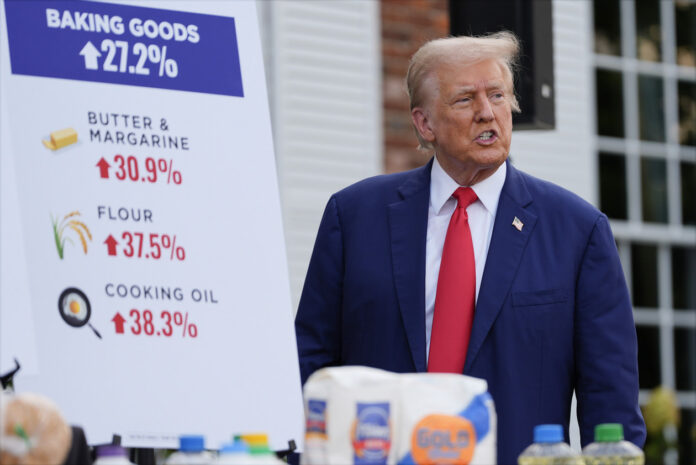Inflation rose in February as consumers prepared for the possible assault of higher costs from President Donald Trump’s broad tariffs on U.S. trade partners.
Excluding food and energy goods, the Commerce Department said Friday that prices increased at an annual pace of 2.8 percent last month, more than predicted, suggesting that prices would rise much more in the next months.
That does not bode well for consumers and companies sensitive to prices—or for Trump’s grand ambitions for the U.S. economy. Most of Trump’s proposed taxes haven’t yet gone into force, even if administration officials including Treasury Secretary Scott Bessent claim that tariff-related inflation would be fleeting. More and more Wall Street experts are sounding alarms that the United States would enter a politically deadly mix of low growth and rising inflation known as stagflation, which the nation has not experienced in more than four decades.
David Alcaly, lead macroeconomic strategist at Lazard Asset Management, remarked in a research note that “Today’s data has the general pattern of what many observers will be looking for in the months ahead as new tariffs and other policy changes begin to bite: weaker-than-expected spending and stronger-than-expected inflation.” “Much still unknown, and it’s too early to start making decisions about effects, but observing this trend in concrete data and not only polls might fuel worry.
The personal consumption expenditures data for February did not show the 25 percent tariffs on steel and aluminum imports starting March 12. It also excluded the impact of the majority of the additional taxes linked to Mexican, Chinese, or Canadian products. It precedes auto sector tariffs—snarled auto supply chains were a significant source of post-pandemic inflation—as well as so-called reciprocal tariffs that are expected to be implemented next week. Import levies on timber, copper, semiconductors, and medicines are all under consideration.
Voters are raising red flags about Trump’s lack of progress on cost-of-living concerns only two months following Inauguration Day. A Gallup survey published Thursday found him 18 points under water on his economic management. Future tariff-related sticker shocks are improbable to enhance those margins.
Wells Fargo Senior Economist Tim Quinlan remarked, “It increases inflation, it damages corporate profits.” From a campaign perspective or a political one, neither of these is a winning plan.
In a letter to clients, Joe Lavorgna, chief economist at SMBC Nikko Securities and former Trump economic adviser, stated that the inflation report bolstered the argument for the president’s other key objectives. These are “legislating supply-side initiatives to boost the economy’s productive capacity, such as extending the 2017 Tax Cuts and Jobs Act,” as well as raising energy production—which he and other Trump loyalists claim will reduce prices.
Many analysts, however, claim that the approaching tariff onslaught would drive prices to a level where consumer spending stops and the economy nearly stops. Last month, spending increased by 0.4%, according to Commerce’s PCE data, below the 0.5% rise forecast by most economists.
Bank of America economists now think that “modest stagflation” is the most probable result for the U.S. this year, and that the mix of poor growth and high prices will keep further interest rate decreases by the Federal Reserve on hold.
“Our starting point is not very favorable, which explains why we are somewhat prone to stagflation right now, particularly the inflation part,” Aditya Bhave, senior U.S. economist and managing director at BofA. Bhave stated that when Trump first term put tariffs on Chinese products, inflation was below the Fed’s 2 percent goal and stores had limited history for transferring more import expenses to customers.
He said, “Now there’s probably more capacity to do that.” “You can see in inflation predictions that people are already anticipating it to a particular degree—at least in certain measures—and that can become self-fulfilling.
Fed officials monitor the University of Michigan’s consumer survey to assess sentiment; it announced on Friday that year-ahead inflation forecasts climbed to 5.0 percent in March, the highest level since November 2022. Party membership showed the rise.
“A significant increase among Republicans as well as a large surge among independents caused expectations for longer-term inflation to also rise,” poll Director Joanne Hsu stated.
Certainly, there is also a school of thinking that argues certain companies can absorb tariff expenses instead of endangering customer breaking point.
According to Wells Fargo analysts in a paper, goods-related sectors have greater profit margins than they had ten years ago, which gives them more leeway to avoid transferring the costs of additional tariffs on to consumers. Trump himself has allegedly cautioned auto industry executives not to raise their prices; Sen. Elizabeth Warren (D-Mass.) this week urged Commerce Secretary Howard Lutnick for details on how the government will prevent major companies using tariffs as “a new set of justifications to price-gouge American consumers.”
But just because some companies can handle more import expenses doesn’t guarantee they will. Sarah House and other Wells Fargo economists noted in their study that they “see risk that companies will more readily try to push price increases through.” Some retailers and manufacturers, like Best Buy and W.W. Grainger, an industrial supplier, cautioned on earnings calls that further tariffs would cause customers to pay more.
Whether or whether the tariff expenses are borne by individuals, the political reality of rising prices may be intolerable.
How many current parties worldwide were stretched out over inflation in the last two years? Quinlan remarked. “I suspect that it’s going to be difficult for administration officials to hold these sorts of changes in place for a particularly long time as profit margins come under pressure and as inflation begins to weigh on consumers.”
